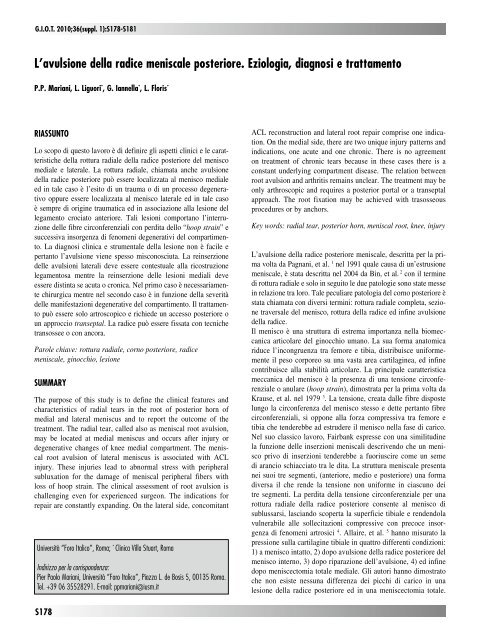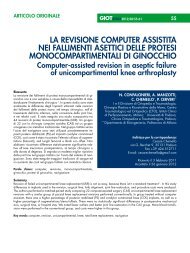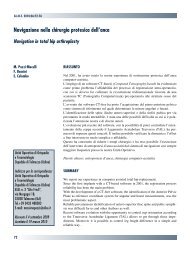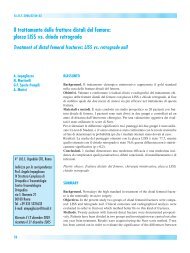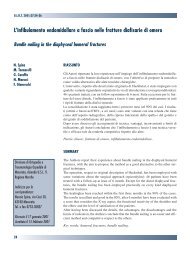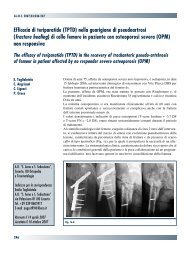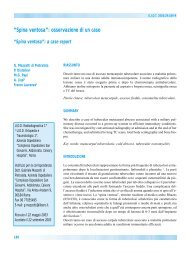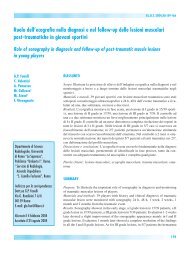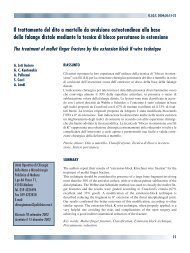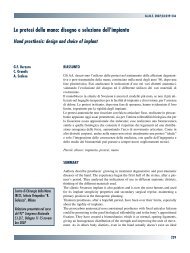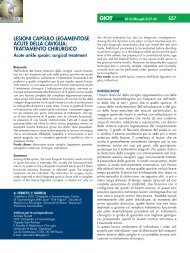30845 Suppl Giot.pdf - Giornale Italiano di Ortopedia e Traumatologia
30845 Suppl Giot.pdf - Giornale Italiano di Ortopedia e Traumatologia
30845 Suppl Giot.pdf - Giornale Italiano di Ortopedia e Traumatologia
You also want an ePaper? Increase the reach of your titles
YUMPU automatically turns print PDFs into web optimized ePapers that Google loves.
G.I.O.T. 2010;36(suppl. 1):S178-S181<br />
L’avulsione della ra<strong>di</strong>ce meniscale posteriore. Eziologia, <strong>di</strong>agnosi e trattamento<br />
P.P. Mariani, L. Liguori * , G. Iannella * , L. Floris *<br />
rIaSSuNTO<br />
Lo scopo <strong>di</strong> questo lavoro è <strong>di</strong> definire gli aspetti clinici e le caratteristiche<br />
della rottura ra<strong>di</strong>ale della ra<strong>di</strong>ce posteriore del menisco<br />
me<strong>di</strong>ale e laterale. La rottura ra<strong>di</strong>ale, chiamata anche avulsione<br />
della ra<strong>di</strong>ce posteriore può essere localizzata al menisco me<strong>di</strong>ale<br />
ed in tale caso è l’esito <strong>di</strong> un trauma o <strong>di</strong> un processo degenerativo<br />
oppure essere localizzata al menisco laterale ed in tale caso<br />
è sempre <strong>di</strong> origine traumatica ed in associazione alla lesione del<br />
legamento crociato anteriore. Tali lesioni comportano l’interruzione<br />
delle fibre circonferenziali con per<strong>di</strong>ta dello “hoop strain” e<br />
successiva insorgenza <strong>di</strong> fenomeni degenerativi del compartimento.<br />
La <strong>di</strong>agnosi clinica e strumentale della lesione non è facile e<br />
pertanto l’avulsione viene spesso misconosciuta. La reinserzione<br />
delle avulsioni laterali deve essere contestuale alla ricostruzione<br />
legamentosa mentre la reinserzione delle lesioni me<strong>di</strong>ali deve<br />
essere <strong>di</strong>stinta se acuta o cronica. Nel primo caso è necessariamente<br />
chirurgica mentre nel secondo caso è in funzione della severità<br />
delle manifestazioni degenerative del compartimento. Il trattamento<br />
può essere solo artroscopico e richiede un accesso posteriore o<br />
un approccio transeptal. La ra<strong>di</strong>ce può essere fissata con tecniche<br />
transossee o con ancora.<br />
Parole chiave: rottura ra<strong>di</strong>ale, corno posteriore, ra<strong>di</strong>ce<br />
meniscale, ginocchio, lesione<br />
SuMMary<br />
The purpose of this study is to define the clinical features and<br />
characteristics of ra<strong>di</strong>al tears in the root of posterior horn of<br />
me<strong>di</strong>al and lateral meniscus and to report the outcome of the<br />
treatment. The ra<strong>di</strong>al tear, called also as meniscal root avulsion,<br />
may be located at me<strong>di</strong>al meniscus and occurs after injury or<br />
degenerative changes of knee me<strong>di</strong>al compartment. The meniscal<br />
root avulsion of lateral meniscus is associated with ACL<br />
injury. These injuries lead to abnormal stress with peripheral<br />
subluxation for the damage of meniscal peripheral fibers with<br />
loss of hoop strain. The clinical assessment of root avulsion is<br />
challenging even for experienced surgeon. The in<strong>di</strong>cations for<br />
repair are constantly expan<strong>di</strong>ng. On the lateral side, concomitant<br />
Università “Foro Italico”, Roma; * Clinica Villa Stuart, Roma<br />
In<strong>di</strong>rizzo per la corrispondenza:<br />
Pier Paolo Mariani, Università “Foro Italico”, Piazza L. de Bosis 5, 00135 Roma.<br />
Tel. +39 06 35528291. E-mail: ppmariani@iusm.it<br />
S178<br />
ACL reconstruction and lateral root repair comprise one in<strong>di</strong>cation.<br />
On the me<strong>di</strong>al side, there are two unique injury patterns and<br />
in<strong>di</strong>cations, one acute and one chronic. There is no agreement<br />
on treatment of chronic tears because in these cases there is a<br />
constant underlying compartment <strong>di</strong>sease. The relation between<br />
root avulsion and arthritis remains unclear. The treatment may be<br />
only arthroscopic and requires a posterior portal or a transeptal<br />
approach. The root fixation may be achieved with trasosseous<br />
procedures or by anchors.<br />
Key words: ra<strong>di</strong>al tear, posterior horn, meniscal root, knee, injury<br />
L’avulsione della ra<strong>di</strong>ce posteriore meniscale, descritta per la prima<br />
volta da Pagnani, et al. 1 nel 1991 quale causa <strong>di</strong> un’estrusione<br />
meniscale, è stata descritta nel 2004 da Bin, et al. 2 con il termine<br />
<strong>di</strong> rottura ra<strong>di</strong>ale e solo in seguito le due patologie sono state messe<br />
in relazione tra loro. Tale peculiare patologia del corno posteriore è<br />
stata chiamata con <strong>di</strong>versi termini: rottura ra<strong>di</strong>ale completa, sezione<br />
traversale del menisco, rottura della ra<strong>di</strong>ce ed infine avulsione<br />
della ra<strong>di</strong>ce.<br />
Il menisco è una struttura <strong>di</strong> estrema importanza nella biomeccanica<br />
articolare del ginocchio umano. La sua forma anatomica<br />
riduce l’incongruenza tra femore e tibia, <strong>di</strong>stribuisce uniformemente<br />
il peso corporeo su una vasta area cartilaginea, ed infine<br />
contribuisce alla stabilità articolare. La principale caratteristica<br />
meccanica del menisco è la presenza <strong>di</strong> una tensione circonferenziale<br />
o anulare (hoop strain), <strong>di</strong>mostrata per la prima volta da<br />
Krause, et al. nel 1979 3 . La tensione, creata dalle fibre <strong>di</strong>sposte<br />
lungo la circonferenza del menisco stesso e dette pertanto fibre<br />
circonferenziali, si oppone alla forza compressiva tra femore e<br />
tibia che tenderebbe ad estrudere il menisco nella fase <strong>di</strong> carico.<br />
Nel suo classico lavoro, Fairbank espresse con una similitu<strong>di</strong>ne<br />
la funzione delle inserzioni meniscali descrivendo che un menisco<br />
privo <strong>di</strong> inserzioni tenderebbe a fuoriuscire come un seme<br />
<strong>di</strong> arancio schiacciato tra le <strong>di</strong>ta. La struttura meniscale presenta<br />
nei suoi tre segmenti, (anteriore, me<strong>di</strong>o e posteriore) una forma<br />
<strong>di</strong>versa il che rende la tensione non uniforme in ciascuno dei<br />
tre segmenti. La per<strong>di</strong>ta della tensione circonferenziale per una<br />
rottura ra<strong>di</strong>ale della ra<strong>di</strong>ce posteriore consente al menisco <strong>di</strong><br />
sublussarsi, lasciando scoperta la superficie tibiale e rendendola<br />
vulnerabile alle sollecitazioni compressive con precoce insorgenza<br />
<strong>di</strong> fenomeni artrosici 4 . Allaire, et al. 5 hanno misurato la<br />
pressione sulla cartilagine tibiale in quattro <strong>di</strong>fferenti con<strong>di</strong>zioni:<br />
1) a menisco intatto, 2) dopo avulsione della ra<strong>di</strong>ce posteriore del<br />
menisco interno, 3) dopo riparazione dell’avulsione, 4) ed infine<br />
dopo meniscectomia totale me<strong>di</strong>ale. Gli autori hanno <strong>di</strong>mostrato<br />
che non esiste nessuna <strong>di</strong>fferenza dei picchi <strong>di</strong> carico in una<br />
lesione della ra<strong>di</strong>ce posteriore ed in una meniscectomia totale.


